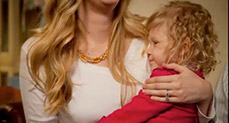How to do a Needleless Valve or Cap Change on a Central Line
PHS IV Nurse Susan Fitzsimmons knows all too well the concerns that families can have when faced with changing their child’s central line cap. For such a seemingly quick and easy process, there is a high potential for illness in your child if the proper steps aren’t taken to ensure a germ-free cap change. Well, have no fear because PHS is here to walk you through the process. Susan details each step along with a few of her tips and tricks in the video below. It’s like having your very own infusion nurse in the home each time you do a cap change.
Should you have any questions after watching the above video or reviewing the steps below please don’t hesitate to contact PHS at 651-642-1825.
Steps for a Needleless Valve or Cap Change on a Central Line.
Preparation for the cap change
- Wash hands (hand sanitizer or soap and water, either is fine). Make sure that you always practice hand hygiene before you do any IV treatments of any kind. Download PHS’s hand washing card here to print out and have next to your household sinks.
- Take a paper drape and place it on your table or floor, wherever you will be doing the cap change. Ensure no pets or children will be able to disturb this area while preparing for and completing the cap change. Place the drape plastic side down.
- Get all supplies ready. If you can get as much done before you’re actually in front of your child, you will be far calmer and not think of the cap change as a stressful process.
a. A new cap in sterile packing
b. Three chlorascrub pads
c. One heparin flush - Open all packages prior to starting.
- Scrub the hub on the new cap (No need to scrub the one currently on your child as it will be discarded in the change). Scrub for 15-30 seconds and let air dry for about 10-15 seconds.
- Remove lid from the heparin syringe while waiting for new catheter cap to dry.
- Hold dry cap and syringe firmly; connect and twist.
- Remove the lid to your cap and prime the syringe by getting the air bubble to the top of the cap.
- Put the lid of your cap back on once you have the air bubble out of the syringe.
Now you’re ready to get your child and before the cap change
- Clamp your child’s line
- Open two of your three wipes
- Pick up the cap that is currently on your child and clean just behind the cap with one of your chlorascrub wipes for the full 30 seconds. Let the area dry completely 15-30 seconds.
- Double check one more time that you have clamped your child’s line. This is very important because if the line is not clamped, when you remove the cap, there is nothing between all the germs in the air and your child’s bloodstream. So it’s very important to ensure the line is clamped.
- Remove old cap
This is the most pivotal point in the process. As Susan calls it “Go-Time”, nothing should distract you from your child in this moment.
- Scrub the end of the catheter for 15-30 seconds, making sure not to get inside of the catheter, just around the threads and the end. You want to scrub very vigorously as you are cleaning germs off of the very most important connection this IV has.
- Once you’ve scrubbed keep a hold of the catheter end, making sure nothing can touch it while it is drying for the full 15-30 seconds. NOTE: You need to make sure to let it dry completely otherwise the cap will stick to the catheter and it will be extremely difficult if not impossible to get it off at the next cap change.
- Remove the lid of the new cap and double check that you have it primed and there is a little bubble at the top of the syringe.
- Connect the new cap to the catheter making sure it’s tight.
- Open the clamp
- Flush in the fluid
- Remove your syringe flush from the cap.
- Clamp your line
- And you’re done!
Congratulations!
Originally published: September 23, 2011

